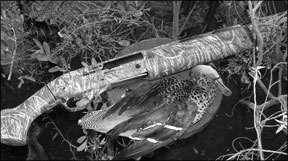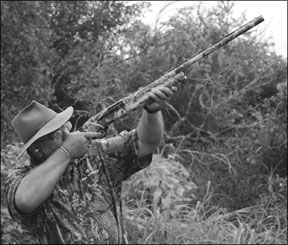While many scattergun enthusiasts may prefer the classic appearance of fine-grained wood and gun-metal blue steel in many shooting situations, the fall season seems to bring out the desire for a little camouflage in their shotgun collection. These firearms are designed for rugged, dependable functioning in what can be miserable weather conditions. Like the runt of a litter of puppies, these shotguns are often so ugly that they are considered attractive.

With the stress on getting the job done, the two shotguns we selected for our testing are promoted as solid shooting tools, capable of handling field conditions without punishing hunters with excessive recoil or clunky handling performance.
Billed as the fastest-functioning semiautomatic on the market, the Winchester Super X3 Waterfowl model is a recent addition to the Winchester line, and the Benelli M2 Field is also a fast-functioning and popular shooting tool in fields and wetlands across the country. Only one dollar separates the two shotguns manufacturers suggested retail prices, which is a rare match in a head-to-head competition between semiautomatics. Both feature slim designs and synthetic camouflage stocks and forearms, plus camouflage-coated barrels. These features are nearly a necessity for anyone venturing into the wet weather, mud and gunk typical of waterfowl hunting conditions and the unpredictable fall season for dove hunters.
How We Tested
Since field shooting was the test track for both our shotguns, we cycled a variety of ammunition through both semiautomatics to check out their ability to handle different loads. Our ammunition selection for this test included Remington STS Low Recoil 2.75-inch loads with a 2.5 dram equivalent, 1 1/8 ounce of No. 7.5 shot and a muzzle velocity of 1,100 fps; Federal Wing-Shok Flyer 2.75-inch loads with 3.25 dram equivalent, 1.25 ounce No. 7.5 lead shot with a muzzle velocity of 1,330 fps; and Federal Ultra-Shok Heavy High Velocity Steel 2.75-inch loads with 3.89 dram equivalent, 1.25 ounces of No. 4 shot with a muzzle velocity of 1,375 feet per second.
We encountered no malfunctions of any kind with any of the shells. Both shotguns cycled the ammo variety with quickness and effectiveness, even in bad weather conditions. Pattern tests resulted in nearly identical 50-50 coverage (half below and half above) on the patterning board with both shotguns, no matter what ammunition was put on paper. Heres our test report in more detail:
Winchester Super X3
12 Gauge, $1216
This gun is billed as the fastest semiautomatic on the market, capable of cycling 12 shots in 1.442 seconds. According to Winchester officials, that rate of fire is equivalent to 457 rounds per minute-about the same as the 50-caliber Browning M2 belt-fed heavy machine gun. For anyone with a couple seconds to spare, a video clip of record-setting performance by professional sport shooter Patrick Flanigan is available at www. patrickflanigan.com.
While fast is fine, we were more impressed with the feel and handling ability of the Super X3. Even in wet and rainy conditions, the slim forearm and grip provided a firm foundation for throwing shot at both doves and ducks.
Recoil was surprisingly slight, even with heavy loads, and second and third shots were cycled by the gas-operated shotgun with the advertised swiftness. Most hunters will be limited to three shots in

their hunting conditions, rather than the 12 shots cycled by Flanigan with machinegun speed, but it was a comfort to know that each round was ready at a very fast pace.
Overall balance and dimensions of the Super X3 met with high praise by our test group. The test model weighed in at 7.1 pounds, and the overall length of the shotgun was 48.9 inches with a 28-inch barrel. Weight reduction in the shotgun was facilitated by a lightweight alloy magazine tube and recoil spring system. The barrel featured an improved ventilated rib design, was back-bored to help reduce recoil, and featured a set of three Invector-Plus choke tubes. In addition, the model included two length-of-pull stock spacers, drop-and-cast adjustment spacers, and sling swivel studs. Another recoil reducing feature was the Pachmayr Decelerator recoil pad.
The length of pull was a shorter-than-normal 14.25 inches (apparently designed for shooters wearing the heavier camouflage clothing necessary for fall shooting), with a drop at the comb of 1.75 inches and a drop at the heel of 2 inches. The stock spacers, plus the drop and cast adjustment spacers, are a nice touch for those with gun fit problems.
All of our test team members were comfortable with the feel and fit of the Winchester out of the box. We particularly liked the Dura-Touch Armor coating in high-definition Mossy Oak Duck Blind camouflage and the manner in which the recoil pad easily slipped into the shoulder.
We found that the coating made the Super X3 one of the most solid shooting foundations of any field shotgun that we have handled-no slips, no fumbles and no hiccups in getting the scattergun into shooting position even in wet and miserable conditions. The trigger pull on the Winchester was in the normal range of 6 pounds, although we would have preferred a slightly lighter touch off. Even at 6 pounds, the pull was crisp and clean.
As noted earlier, there were no problems with cycling all types of ammunition through the Super X3. We did note that empty hulls were ejected with authority-landing several yards away from our shooting positions. Unless a shooter is attempting to salvage hulls for reloading, this is a very pleasing feature.
Benelli M2 Field
Semiautomatic 12 ga., $1215
This gun is no slouch in the cycling arena, and while slower than the Winchester, it put rounds downrange in a quick and effective manner.
Our test model featured a 26-inch barrel, with an overall length of 47 inches. The shotgun is covered in a Realtree Camo Max-4 camouflage design with AirTouch checkering.
We found the feel and handling ability of the Benelli to be as good as the Winchester-there was very little difference in the two field guns when weather and hunting conditions were less than favorable.
The inertial operation of the recoil system, combined with the turning block bolt locking system, provided a different feel to shooting the Benelli than with the gas-operated Super X3 . However, recoil with all loads was acceptable and although the Benelli was a little slower in the cycling department, we encountered no functioning problems.
Tipping the scales at 7 pounds on the nose, we liked the heft and easy movement of the Benelli. The length of pull was a shorter-than-normal 14 inches. Like the Winchester, this allows for the additional padding of a heavy coat or shooting gear. The drop at the comp was 1.5 inches and the drop at the heel was 2 inches.
As with the Winchester, these dimensions fell within the comfort zone of our test group. If there had been adjustment problems, the M2 also features a shim kit to tweak drop and cast in the stock.
The ComfoTech System in the stock and the Technogel recoil pad lived up to their advertising in reducing recoil, even with heavy loads. While their looks are unusual, they do get the job done. We were a little unhappy with the trigger pull weight of 6.5 pounds, with just a little creep before touch off. A trip to the neighborhood gunsmith for a minor adjustment would be a good idea.
With its 26-inch barrel, the Benelli was quick and smooth to the targets. We found that second and third shots were no problem and the shotgun always did its job in an effective manner. Some of the test team members experienced a little “bite” from the loading port when attempting to shove shells into the magazine. An inconvenience, but worth noting for those people who want to avoid sore thumbs after shooting .
Assembly and reassembly of the Benelli was very easy and uncomplicated-a big plus with semiautomatics that must function in rugged conditions.


























